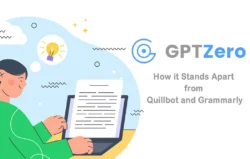Grammarly started as a simple spelling and grammar checker in 2009 and has since developed into a full-featured AI-powered writing assistant. This shift has completely transformed the way that individuals and professionals approach written communication. Originally created to help students and scholars, Grammarly has grown into a flexible tool that millions of people use to improve the efficacy, originality, and clarity of their writing. Writers, marketers, and business professionals are among its users.
Grammarly nowadays uses artificial intelligence (AI), machine learning and natural language processing (NLP) to continuously improve its features to satisfy the needs of a digitally growing world. In this article, we will examine Grammarly’s AI-powered features, plagiarism detection for writing original content, and how it is helpful in search engine optimization (SEO).
Grammarly’s AI Evolution Since 2009
Alex Shevchenko, Max Lytvyn, and Dmytro Lider founded Grammarly in 2009 with the goal of enhancing communication via technology. In order to analyze text and offer recommendations for spelling, grammar, and style, the platform integrated AI right away by fusing rule-based systems with natural language processing. Grammarly’s AI was created to comprehend context, which allowed it to provide subtle corrections that maintained the writer’s voice, in contrast to simple spell-checkers. Grammarly is now a leader in AI-driven writing help thanks to its expanded capabilities over the years, which were made possible by developments in machine learning and deep learning.
Grammarly’s initial focus was on academic users, assisting researchers and students in refining their essays and papers. In 2015, it introduced app integration features, which make it possible to use Grammarly features within Microsoft Word, Google Docs, etc. and with their browser extensions, it was easy to correct grammar while writing an email in web browsers. Later in 2023, they will introduce generative AI capabilities that will allow Grammarly to work with contemporary AI tools like ChatGPT by producing content in response to user inputs in addition to correcting it. Grammarly’s AI now includes advanced algorithms that examine context, tone, and clarity to make sure recommendations are appropriate for the user’s audience and intent.
Key AI-Powered Features of Grammarly
Grammarly’s suite of features is powered by its advanced AI, which integrates machine learning, NLP, and insights from linguists to deliver comprehensive writing support. Below are some of its core features:
1. Grammar and Spelling Checker
Grammarly’s core feature is its real-time grammar and spelling correction. Unlike any other spell-checkers, Grammarly’s AI examines syntax, context, and sentence structure to give users precise recommendations. It assists users in writing in a professional manner by pointing out even basic problems like subject-verb agreement, misplaced modifiers, and punctuation mistakes.
2. Style and Tone Adjustments
Grammarly’s AI evaluates the tone of a text and suggests adjustments to align with the desired audience or purpose, such as formal, informal, persuasive, or confident tones. This feature is particularly valuable for professionals crafting emails, reports, or marketing content, as it ensures the tone matches the context.
3. Clarity and Conciseness
The AI-powered clarity checker identifies wordy or ambiguous sentences and suggests concise alternatives. This enhances readability, making content more engaging for readers and improving its effectiveness in professional or creative settings.
4. Plagiarism Detection
Grammarly’s plagiarism checker, introduced as a premium feature, scans text against billions of web pages and academic databases, such as ProQuest, to identify potential matches. It provides an originality score and highlights duplicated content, offering citation suggestions in formats like APA, MLA, or Chicago to help users maintain academic and professional integrity.
5. Generative AI and Paraphrasing
In 2023, Grammarly launched GrammarlyGo, a generative AI tool that creates text based on user prompts, assists with brainstorming, and rewrites content for clarity or style. Unlike traditional corrections, GrammarlyGo can generate outlines, draft emails, or rephrase sentences while preserving the user’s voice, making it a powerful tool for content creation.
6. Grammarly Authorship
Introduced in 2024, Grammarly Authorship is a unique feature that tracks the origin of text in real-time, categorizing it as human-typed, AI-generated, or sourced externally. This tool provides a shareable report, ideal for students and professionals to demonstrate the authenticity of their work, particularly in academic settings.
7. Citation and Formatting Assistance
Grammarly’s AI assists with proper citation formatting and style guide adherence (e.g., APA, MLA, Chicago), reducing the risk of unintentional plagiarism. It also checks for formatting consistency, such as stray periods or misplaced parentheses, ensuring polished documents.
8. AI Detection
Grammarly’s AI detector, integrated into its plagiarism checker, identifies text that may have been generated by AI models like GPT-4 or ChatGPT. This feature promotes transparency by flagging AI-generated content, helping users ensure their work aligns with ethical standards, especially in academic or professional environments.
These features are accessible via Grammarly’s browser extensions, desktop apps, mobile apps, and integrations with platforms like Microsoft Word and Google Docs, making it a versatile tool for writing across contexts.
Plagiarism Detection and Supporting Original Content
Plagiarism, whether intentional or accidental, can have severe consequences, including academic penalties, professional reputational damage, or SEO penalties for duplicated content. Grammarly’s plagiarism checker is a cornerstone of its commitment to fostering original writing. By scanning text against billions of online sources and academic databases, it identifies potential matches and provides detailed reports with links to original sources. This allows users to revise duplicated content and add proper citations, ensuring originality.
Grammarly’s AI goes beyond detection by offering tools to create original content. The generative AI feature, GrammarlyGo, enables users to draft unique content based on prompts, reducing reliance on external sources. Additionally, Grammarly Authorship provides transparency by documenting the writing process, which is particularly valuable for students and educators to verify the authenticity of work. For example, Authorship’s replay feature allows users to review the document’s creation from start to finish, providing evidence of original effort.
However, Grammarly’s plagiarism checker has limitations. Studies have shown it detects only about 51% of plagiarized content at a 5% threshold, compared to competitors like Originality.ai (67.5%) or Turnitin (52%). It may struggle with heavily paraphrased text or partial matches, and its interface uses a single color for all sources, which can make reports harder to parse. Despite these drawbacks, Grammarly’s emphasis on citation suggestions and transparency features like Authorship makes it a valuable tool for maintaining academic and professional integrity.
Grammarly’s Role in SEO
For content creators and digital marketers, Grammarly plays a significant role in optimizing content for search engine optimization (SEO). High-quality, original content is critical for ranking well on search engines like Google, which penalizes duplicate or poorly written content. Grammarly supports SEO in several ways:
1. Improving Readability
Search engines prioritize content that is clear, concise, and engaging. Grammarly’s clarity and conciseness suggestions ensure text is easy to read, reducing bounce rates and increasing user engagement, both of which are key SEO metrics.
2. Ensuring Originality
Duplicate content can harm a website’s SEO ranking. Grammarly’s plagiarism checker helps marketers verify that content is unique, avoiding penalties from Google’s algorithms. By suggesting citations for borrowed ideas, Grammarly ensures content adheres to ethical standards, further boosting credibility.
3. Enhancing Keyword Integration
While Grammarly does not directly optimize for keywords, its tone and style suggestions help create natural, reader-friendly content that aligns with SEO best practices. For example, it can refine sentences to incorporate keywords seamlessly without compromising quality.
4. Supporting Consistent Branding
Grammarly’s Custom Style Guides allow businesses to train the AI on their brand voice, ensuring consistent tone and style across content. This consistency enhances user experience, which indirectly supports SEO by improving dwell time and engagement.
By combining these features, Grammarly helps content creators produce high-quality, original content that aligns with Google’s E-E-A-T (Experience, Expertise, Authoritativeness, Trustworthiness) guidelines, a critical factor for SEO success in 2025.
Challenges and Ethical Considerations
While Grammarly’s AI tools are powerful, they are not without challenges. AI detectors, including Grammarly’s, can produce false positives, flagging human-written text as AI-generated, particularly when edited extensively with Grammarly’s suggestions. This has raised concerns in academic settings, where students using Grammarly have been flagged for AI use, leading to calls for clearer guidelines on responsible AI use. Grammarly addresses this by emphasizing transparency through features like Authorship and advising users to retain pre-edited drafts to verify originality.
Ethically, Grammarly promotes responsible AI use by allowing users to control generated content and providing tools to attribute sources correctly. However, its generative AI features raise questions about over-reliance, as excessive use could diminish a writer’s originality or critical thinking, a concern echoed in discussions about AI ethics in content creation.
Future Plans for Grammarly
Grammarly’s future plans center on deepening its AI capabilities while prioritizing responsible use and transparency. Key initiatives include:
1. Enhancing AI Detection and Authorship
Grammarly aims to refine its AI detection algorithms to reduce false positives and improve accuracy in distinguishing between human and AI-generated text. The expansion of Grammarly Authorship will further support transparency by providing detailed insights into the writing process, benefiting educators, students, and professionals.
2. Expanding Generative AI Capabilities
Grammarly plans to enhance GrammarlyGo with more advanced generative features, such as creating complex documents or tailoring content for specific industries. This will make it a more robust tool for professionals in fields like marketing, legal, and technical writing.
3. Supporting Multilingual Content
With the growing demand for global communication, Grammarly is exploring AI enhancements to support non-English text analysis and plagiarism detection across multiple languages, making it more accessible to international users.
4. Collaborative Industry Guidelines
Grammarly is committed to collaborating with educators, professionals, and technology providers to develop clear guidelines for responsible AI use in writing. This includes addressing concerns about AI plagiarism and ensuring tools like Grammarly align with academic and professional standards.
5. Integration with Emerging Technologies
As AI and NLP technologies evolve, Grammarly plans to integrate with emerging platforms, such as virtual reality or voice-based interfaces, to provide real-time writing assistance in new contexts.
Conclusion
Grammarly’s journey since 2009 reflects its commitment to harnessing AI to improve communication while addressing the challenges of originality and ethics. Its AI-powered features, from grammar and tone adjustments to plagiarism detection and generative AI, have made it an indispensable tool for writers, students, and professionals. By supporting original content creation and aligning with SEO best practices, Grammarly empowers users to produce high-quality, engaging, and credible content. Looking ahead, Grammarly’s focus on responsible AI use, enhanced detection, and multilingual support positions it as a leader in the future of AI-driven writing assistance. As the digital landscape evolves, Grammarly’s innovations will continue to shape how we communicate, ensuring clarity, originality, and impact in every word.







